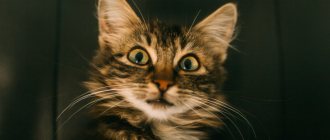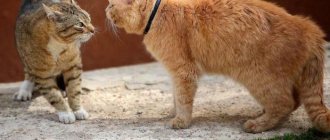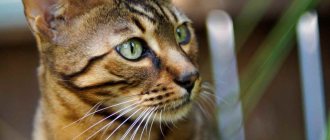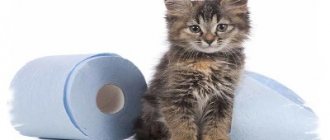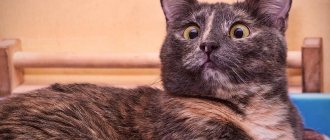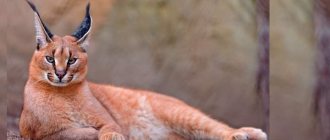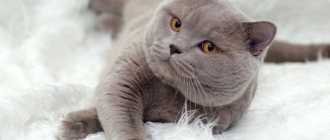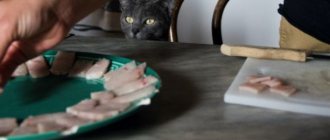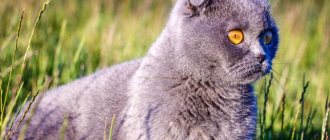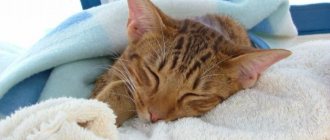When choosing a pet, most people look for a healthy and attractive animal. But there are exceptions when, behind the superficial imperfections, some people see the zest in a pet and would not exchange their friend for anyone.
Cats with slanted eyes look unusual and cute, but a good owner always thinks whether this is dangerous for their health and why the animal acquires such a defect.
Does it happen to cats?
Strabismus, or strabismus, can be diagnosed in cats at any age. The pathological process develops as a result of disruption of the eye muscles or nerve fibers. Strabismus can be a genetic feature, that is, it can be transmitted hereditarily. Siamese and Oriental breeds are considered prone to the disease.
Strabismus occurs:
- unilateral (one eye is deviated from the normal position);
- bilateral (there is a deviation from the visual axis of both eyes).
Depending on which eye is looking where, the following types of strabismus are distinguished:
- Esotropia, or convergent strabismus. Occurs most often. It manifests itself as a shift of the pupils towards the nose.
- Exotropia, or divergent strabismus. Characterized by dilation of the pupils towards the temples.
Strabismus, regardless of its type, is considered a deviation from the norm.
In Siamese, Thai and other breeds
There are no breeds in which all representatives have strabismus. Strabismus can be diagnosed in any cat. But there are breeds in which this pathology is diagnosed more often than others:
- Thai;
- Siamese;
- Javanese;
- oriental;
- Balinese;
- snowshoe.
Scientists believe that strabismus in animals occurs due to acromelanism, a manifestation of the gene that is responsible for coat color and eye color. But acromelanism can also disrupt the process of proper development of the optic nerve, which is why strabismus appears.
The pathological process of the organs of vision is not always treatable.
In kittens at an early age
At an early age, strabismus is often observed in kittens. This feature does not always indicate a physiological deviation.
Pupils looking in different directions may be evidence that the eye muscles have not yet had time to strengthen. This type of strabismus does not require treatment. In most cases, by 5 months the eyeballs are in the correct position.
If a kitten has congenital strabismus and has a genetic predisposition to such a feature, then the likelihood that the animal’s eyes will take the correct position is minimal.
It is recommended that your pet be seen by a doctor, but in most cases no medical intervention is required. The animal will be able to develop normally and live with this pathology. Hereditary strabismus does not cause any inconvenience or harm to the cat.
Clinical picture and diagnosis
First, one or both of a cat's eyes can point in any direction. In some cases, the movement of the pupils is completely uncoordinated; they move “on their own.” But this is rare. This happens either when “combined” with nystagmus (in Thai cats), or with serious neurological pathologies.
This is also indicated by an enlarged or constricted pupil, unsteady walking, tilting the head to one side, and frequent collisions with interior objects. Serious behavioral pathologies or neurological seizures are possible. In severe cases, appetite may decrease, sometimes leading to coma (cancer, encephalitis).
As a rule, when making a diagnosis, they focus on clinical manifestations, and this is quite enough. But here it should be remembered that acquired strabismus is often only a symptom indicating much more serious problems. These are the ones that need to be identified during diagnosis.
Causes
If strabismus is not a congenital defect, but appears at an early age or occurs later, its causes may be as follows:
- injuries (impacts);
- benign and malignant neoplasms;
- damage to the eye muscles;
- glaucoma;
- pathologies of the vestibular apparatus;
- infectious diseases;
- diseases of the nervous system;
- brain pathologies.
A veterinarian will help you find out the cause of strabismus and choose the appropriate treatment. Diagnosis includes collecting general information and examining the eyeballs. Additionally, an ultrasound, x-ray, magnetic resonance imaging or other examinations may be required.
Provoking factors of development
Feline strabismus is medically called strabismus. Pathology can be either congenital or acquired. In the latter case, the defect develops against the background of injuries - severe blows to the head or due to falls. Also, a kitten can become cross-eyed after certain diseases:
- developmental pathologies or disturbances in the functioning of the vestibular apparatus (disorientation);
- encephalitis is a viral pathology accompanied by inflammation of brain tissue;
- dysfunction of the central nervous system organs;
- hydrocephalus or dropsy - a disease accompanied by the accumulation of cerebrospinal fluid in the head;
- rabies;
- meningitis - inflammation in the mucous membranes of the brain or spinal cord;
- otitis of the middle or inner ear;
- glaucoma – sudden changes in pressure inside the eye;
- The feline leukemia virus is a disease whose symptoms are very similar to cancer.
Small decorative breed rabbits: review
Strabismus sometimes appears due to a hereditary predisposition. If the genetic eye disease is mild, then there is no need for treatment. Oblique cats quickly adapt and are able to lead a full life.
Important! A purebred cross-eyed cat should not be allowed to be bred in the future.
After injury, due to physical impact, the eyeball deviates from its usual, correct position. Diseases that affect muscle tissue can also provoke strabismus. The cause of the shift may be the development of a neoplasm inside the orbit or the occurrence of inflammatory processes.
Problems in the functioning of the vestibular apparatus lead to the fact that the eyeballs can change their location. The fact is that thanks to the vestibular system, a cat can navigate in space. If something doesn’t work correctly, the brain is not able to correctly perceive information about the position of the head, which, in fact, becomes the cause of strabismus.
Clinical picture of rabies in cats
The development of strabismus can also be provoked by a disturbance in the interaction of the organs of the nervous system (CNS) with the organs of vision.
Note! The occurrence of malignant processes in the brain quite often provokes the development of strabismus.
Treatment
For treatment, the animal may be prescribed medications, but the possibility of surgical intervention cannot be ruled out. Therapy depends on the type and cause of the pathology.
Most often, drug therapy is prescribed to animals with infectious lesions. After suppressing the inflammatory process, the position of the eyeballs returns to normal. All medications, their dosage, duration of treatment are prescribed by a doctor.
Operation
Surgery is performed when drug therapy cannot eliminate the cause of strabismus, for example, if there is a tumor or damage to the eye muscles.
If surgery is recommended for your animal, the procedure should not be delayed. The sooner the surgery is performed, the higher the chance of treatment success.
At home
If the cat is prescribed drug therapy, treatment can be carried out at home. The owner can care for the animal. Your cat may need:
- rubbing the eyes;
- taking pills;
- use of painkillers.
If the doctor has prescribed IVs or injections, it is not necessary to hospitalize the cat. Many veterinary clinics offer home visits.
Traditional methods
If the cat squints only in one eye, then you can try to correct the position of the visual organ with a bandage. The animal needs to close its healthy eye every day. The bandage is applied for several hours.
Traditional methods can be combined with traditional treatment. For example, when diagnosing inflammatory processes, you can make lotions that are prepared from chamomile decoction. Traditional medicine can help eliminate the pathology, but provided that there are no indications for surgical intervention.
Before using unconventional methods, you should consult your veterinarian.
Short tail
It is noteworthy that the presence of a tail in a “rudimentary” state or its complete absence in cats is a sign of “noble” origin (in contrast to the same domestic dogs, whose tails are docked deliberately - to fit the animals to the standards of a particular breed). It is worth noting that there are only a few types of short-tailed/“tailless” cat breeds, which include:
Kurilian Bobtail
a short curved tail approximately 5-9 cm long, resembling a fluffy pom-pom and characterized by mobility, a relatively small body with strong bones, developed muscles and limbs of medium length, a triangle-shaped head with medium-sized eyes corresponding to the color, short-haired or semi-long-haired, but in in any case, with a fluffy collar on the neck and chest.
more details
American Bobtail
a short and flexible tail from 2.5 to 8 cm long (it can be straight, curved, and slightly curled at the end), a body of medium length with an athletic build and strong paws proportional to it, a round muzzle with strong jaws and ears, an internal the surface of which is covered with long fluffy hairs, short or long hair, but always thick and slightly harsh.
more details
Japanese Bobtail
a short tail no more than 12 cm long (straight, curled, curved or in the form of a pompom), a long and lean body with a flat back and slender legs (the hind legs are noticeably longer than the front ones), a muzzle with large oval-shaped eyes and large, wide-set ears, soft and silky coat of medium length.
more details
Mekong Bobtail
a short and broken tail with a length of at least three vertebrae (but no more than a quarter of the length of the body itself), a strong and muscular body of medium size with long legs, a wedge-shaped head with medium-sized ears (with rounded tips) and slightly slanted eyes, always bright blue , short silky coat with minimal undercoat.
Karelian Bobtail
a short tail 4-13 cm long (can be either kinked or almost straight), a strong body with an even posture and proportional paws, a narrow head with a small strong chin and rather large ears with tiny “tassels”, short or long hair ( necessarily dense).
Kurilian Bobtail
“no, not a relative”
short tail 3-8 cm long (with pronounced kinks), strong build with a slightly arched back and powerful paws, large trapezoidal head with a powerful chin and proportional ears, short or long hair (very soft to the touch).
more details
Pixiebob
short straight (but possible kinks) tail about 5 cm long, large and muscular body build with powerful bones and a clearly defined arch on the back, large pear-shaped head, tightly knit and strong paws (the hind legs are noticeably longer than the front ones), short or moderately long hair with different color options, but always with small or medium spots throughout the body.
more details
Manx cat
they may either have no tail completely, or have a small “stump” hidden under the fur, or generally have a tail of normal length, a medium-sized round body with a round head, powerful limbs with well-developed muscles (the front ones are noticeably shorter than the back ones), round eyes with a slight slant, short and thick coat, like “plush”.
more details
Cymric cat
Kymrik
tailless breed (but there can be either a “stump” or even a full tail), a tightly built physique with a wide chest and an arched back, short front and long hind limbs (with heavy shins), thick hair of medium length.
more details
Prevention
To prevent your cat from developing strabismus, it is necessary to undergo an annual preventative examination at a veterinary clinic. If any diseases are detected, treat immediately. You should also contact a veterinarian if the animal has problems with coordination, has had a head injury, or the integrity of the eyelid tissues has been compromised.
The animal should not be allowed to walk unattended or have contact with other people's cats. This can lead to conflict, and the pet may get hurt as a result of the fight.
Congenital strabismus cannot be prevented in breeds that are prone to this feature.
Cat breeds prone to strabismus
A dog whose eyes fall out: a review of breeds
There are breeds of cross-eyed cats that are more likely to develop this pathology. It may appear, or it may bypass the pet. A characteristic feature of these breeds is that they all have an acromelanic color. These include Neva Masquerade, Siamese and Thai cats. Also, the risk group includes completely outbred representatives of the species with a color point color.
Important! Pedigree animals with strabismus cannot perform at exhibitions, since this is a fairly significant reason for disqualification. This should be taken into account by people who want to purchase a purebred animal and perform with it at exhibitions, as well as breed it for sale.
Thai cat with squint
Appearance
Georgian cats are elegant, graceful animals, endowed with a special “oriental” charm. Males are slightly larger than females, the former weigh 6–8 kg, the latter – about 5 kg.
A description of the appearance of a Georgian cat according to the breed standard is given in the table.
| head | small, narrow, elongated, triangular in shape (an equilateral figure is formed by connecting the ends of the ears and chin) |
| eyes | large, almond-shaped, set close to each other, iris color varies, determined by color, but most often green, white individuals have blue eyes |
| ears | large with a wide base and sharp tips, widely spaced |
| nose | long, with a large lobe, the angle between the nose and forehead is not pronounced |
| torso | long, lean, sinewy, developed muscle mass, lean, thin skeleton, tucked belly, narrow but voluminous chest, often protruding in a keel-like manner |
| limbs | long, slender, strong, the hind legs are slightly longer than the front ones, the paws are small, oval |
| tail | long, thin, whip-like |
| wool | short, no undercoat, guard hairs silky, shiny |
There are a huge number of colors of oriental cats; more than three hundred are known. Basic options:
- chocolate;
- lavender (silver-gray with a pink tint);
- blue;
- cinnamon (light brown);
- faun (beige);
- red;
- black;
- white;
- tabby – patterned (stripes, spots, marble);
- ticked (each hair is divided into two parts according to color).
Interesting facts about exotic cats
- The Cat Fanciers' Association (CFA) annually calculates breed rankings based on the number of registrations of pedigreed cats. According to this organization, in 1999 exotics took fourth place in the world in popularity, and in 2012 they took second place, second only to their ancestors - the Persians. Since the age of 14, they have been confidently leading. However, in Russia the situation is different and here, in terms of demand, exotics hardly make it into the top ten breeds;
- Life is hard for show exotic cats. To improve their coat, they are constantly bathed - once or twice a week for two or three months before the show. And kittens who need to make a career have to take a bath 2 times a week, starting from 3 months of age;
- Cats make a career not only at exhibitions. They acquire millions of fans in the virtual space, of course, with the help of loving owners. Among them is the cutie exotic Snoopy, red van color. His name began to be used as a common noun for the entire breed. Snoopy was born and has been living in China since 2011, and his owner is diligently promoting her pet. He does not have any talents, he simply advertises his breed and demonstrates what a well-groomed exotic should look like;
- Initially, they planned to name the breed “Sterling” - silver, since the kittens offered by CFA as a sample were obtained from chinchilla Persians and had a silver color. But since this name narrowed the idea of the new breed, the association council preferred a more capacious one: “exotic shorthair”, allowing in the breed standard a variety of colors typical of Persians;
- After the recognition of the breed in 1966, exotics had a rapid career. In 1971, the exotic was awarded the title of CFA Grand Champion. The black smoke cat named Docia Dao Triby received the CFA National Winner award three times. In 1991, the exotic brown tabby Jovanthe Legend was recognized as the best cat of the year.
